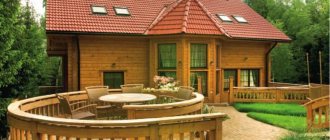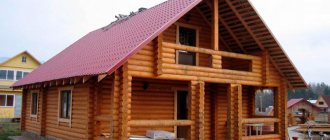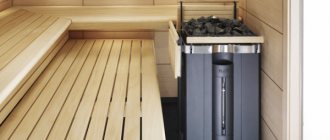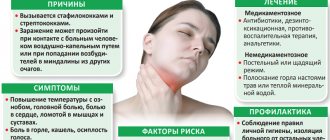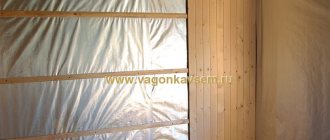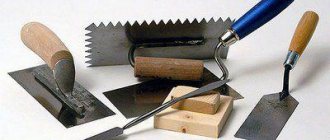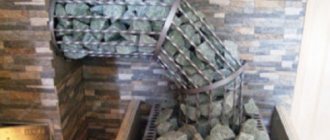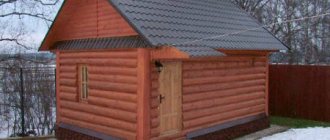The main rule when choosing a heater stove is one: the sauna stove must have OPTIMUM power! The heater can have any design, any size, it can be electric, wood-burning or gas, it can be cheap or expensive, simple or exclusive, it can be absolutely anything according to all criteria except one - it must be installed correctly and in terms of power it must exactly match your steam room.
IN THE ARTICLE:
- “Incorrect” sauna stove power
- Excess power
- Lack of power
- Calculation of the optimal power of a sauna stove
- Determining the cubic capacity of the steam room
- Adjustment of cubic capacity
- Thermal power and stones for sauna stoves
The importance of careful calculations
Regardless of what type of stove is installed in the bathhouse, double-circuit wood-burning, electric, metal or brick, you need to correctly calculate its parameters. It is worth giving clear examples of the importance of the characteristics of a heating unit.
- If you choose the wrong stove for a sauna by volume, it will be impossible to achieve ideal steam. If the installation power is insufficient, it is simply impossible to warm up the room.
- An equally unpleasant situation is when the design of a sauna stove deliberately overestimates its power. The steam room will constantly overheat. Therefore, we will have to ventilate it and make visits shorter.
- If you choose too large a furnace volume and quantity of stone for a wood-burning sauna, it will be impossible to obtain stable steam. Without ventilation, the room will become extremely hot. And if you achieve relative comfort by opening the doors and reducing the entry time, you will have to put up with changes in the temperature of the steam, both at the floor and on the top shelf.
There are other difficulties caused by incorrect calculations. In particular, certain algorithms for determining the mass of stones can force the owner of a bathhouse to build powerful supports - scales, the task of which is to withstand significant loads. Therefore, the calculation of the power of a sauna stove must be done carefully, taking into account the nature of the steam room: Russian bath or Finnish sauna.
Oven functions
A sauna stove is essentially a heating device. Its task is to maintain a certain temperature and humidity in a specialized room.
Based on the fact that we choose the main element for a bath or sauna, its tasks boil down to providing the following conditions for a comfortable stay:
- heating the air to 120℃;
- maintaining humidity 15 – 20%;
- uniform heating of stones;
- safe removal of combustion products.
Calculations for a Russian bath
A Russian bath always involves the use of a large amount of hot steam. In this mode, it is important to take into account each of the factors of circulation and conversion of thermal energy. In the bathhouse, it is necessary to ensure uniform heating conditions, both at floor level and on the upper shelves.
Calculating the power of a stove for a Russian bath takes into account not only the basic energy output for heating the volume of the room, but also the heat loss factors existing in the steam room . To determine the required heating device performance, you must:
- Calculate the total volume of the steam room. To determine it for a room with a rectangular floor, just multiply the width, height, and length of the room. If the steam room has a complex shape, its volume must be divided into separate parallelepipeds and their indicators must be summed up.
- If the room has brick walls, you need to take into account the additional power to heat this heat-intensive material. To do this, calculate the area of the masonry and take an additional volume of cubic meter for each square meter. m.
Then the complex processes of calculating heat loss begin. For single glass windows, you need to add 3 cubic meters to the total heating volume for every square meter of its area. In the case of double glazing, this figure is 1.5 cubic meters per square. Next, the increase in heating volume for doors is calculated. To do this, add 1.2 cubes per square of their area.
The next step is an adjustment for general insulation. If the bathhouse was built according to the basic recommendations, with mandatory waterproofing of the walls and gluing of finishing joints, there is no need to make changes to the already calculated volume for heating. In the case where a simple room without special insulation is allocated for a steam room, you should add 20 to 30% to the final cubic footage.
The last tolerance takes into account the nature of the heating. If the stove is located in an adjacent room, it is required to add another 10% to the final figure of the calculated volume. The resulting value is the minimum acceptable indicator.
Advice! In general, calculating the power of a sauna stove is very simple. It is enough to assume that heating one cubic meter of volume requires 1 kW of thermal energy. This is true for a Russian-style bathhouse.
Steam room dimensions
What should be the comfortable size of a steam room?
Optimal steam room size
The size of the steam room will depend primarily on your personal preferences, and then on the size and design of the shelves. In addition, the size of the bath will be affected by the power of the stove, since sitting too close to it is not very pleasant. The size of the oven is also important. However, if there is a shortage of space, you can use a mineralite screen, which will allow you to be even at a distance of 15-20 cm from the stove and not feel discomfort. And all thanks to the fact that this material does not heat up to more than 100-150 ° C.
But before buying a stove, you should pay attention to the functions that the steam room will perform. If we talk about approximate dimensions, then the ceiling height of the room should be about 2.2-2.4 m. But the width should be calculated depending on the expected number of seats in the steam room. It is better to make it in the form of a rectangle rather than a square.
Simple rural or country baths consist of a steam bath and a dressing room. The stove is usually installed in a steam room, while the dressing room is heated by heat that passes through the adjacent wall when the doors to the steam room are open. Often, another stove is placed in the dressing room for heating, usually a metal one - a “potbelly stove”.
To allow you to steam while lying down, shelves are installed in the steam room. The structure of the shelf should be such that, if desired, one could sit on it. Thus, the ceiling height must ensure comfortable placement of people on the shelf.
More comfortable baths are built in such a way that several people can use them at the same time. Baths for the whole family usually consist of a steam room, a dressing room, that is, a dressing room, and a hallway. The dimensions of the steam room should be such that the room has shelves, retractable benches, a water tank, and a stove. It is necessary that the width of the shelves be at least a meter. The distance from the shelf to the stove is also at least a meter. From the stove to the wall - about 50 cm. There should be free space in the room so that a person can feel comfortable being here. In addition, it is necessary to allocate space for basins and buckets. Several shelves should be placed on the wall to place shampoos, washcloths and other accessories.
Advice from the master!
The optimal calculation is not difficult to carry out. In order to better imagine what dimensions the steam room should have, you can make a drawing on a sheet of paper using a scale. Place the necessary items on the steam room drawing and see how comfortable the room is.
Calculation for sauna
A classic sauna does not imply the generation of a large amount of water vapor in the steam room. This is the so-called dry heat. This is why the Finnish sauna is so popular among consumers. Solutions for its organization can be found in a huge range on the mass market.
Important! A classic sauna can be arranged even within an apartment. At the same time, there will be no need for special insulation and waterproofing in the room.
A small amount of water vapor can be generated for personal enjoyment. That is why even ready-made electric stoves for Finnish saunas are equipped with stones. However, this thermal energy conversion process may be considered insignificant and ignored.
What kind of stove to put in a sauna-type bathhouse, where you don’t need a large amount of steam, volume for people to move and wave brooms, is decided by its owner. You can go the hard way. In this case, the calculation is made according to the above algorithm.
A simpler method involves operating with average heat generation indicators. Today there are quite a lot of ready-made solutions on the market in the form of stoves for Finnish saunas. They can be wood-burning or electric. The manufacturer indicates either the optimal volume of the steam room or the power consumed by the heating elements. The average statistical figures for thermal generation requirements for different types of buildings look like this:
- walls made of wood (profiled, laminated timber, rounded logs) for a thickness of up to 140 mm - 1.5 kW per cubic meter of volume;
- for walls made of wood with a thickness of more than 140 mm - 1.75 kW per cubic meter;
- in buildings built using frame technology, including SIP panels - from 600 to 800 W per cubic meter.
Advice! These figures are correct for wooden walls that have not been insulated. If the owner of the bathhouse acted prudently and made a special finish, the standards for heating can be taken at a level corresponding to the frame construction technology.
For a sauna installed inside a house or apartment with existing central heating, there are other recommendations. In this case, electric units are usually used. Their power must be selected at the rate of 700 W per cubic meter of steam room volume.
Durability
The service life of the unit is always no less important than quality and safety.
And if the costs are high, then at least let them be justified. Here we can safely say that brick and cast iron options will serve faithfully when used correctly. For those who are not ready to spend a lot of money, the best solution would be to purchase a model made of steel with a high chromium content.
When choosing a heating device, you should not rush: consult with specialists, decide on the type and material of construction, and the type of fuel. It is important to correlate personal preferences with the capabilities of the chosen model. Remember the main thing: the best oven is a safe one.
Afterburner reserve
Experienced builders of baths and saunas recommend increasing the final power of the stove by 10-15% of the calculated one. The idea of such an action is very simple. Firstly, the ease of use of the oven is improved. It does not need to be heated to the limit and constantly monitor the amount of fuel or temperature. The unit will not operate at peak power levels, allowing a certain range of adjustment.
Secondly, for bathhouses that are not constantly visited, it becomes possible to quickly warm up with afterburner. This is especially important for buildings in suburban areas. For such a bathhouse, which in winter can literally freeze through and through, you can accept a tolerance of 20%. This will allow you to quickly prepare the room and quickly start taking thermal procedures.
These figures are correct for wood-burning stoves. If an electric unit is used, a power reserve is always made. This may be a tolerance of 10-15% to neutralize possible voltage surges and different heat transfer modes. If there is a need for accelerated heating of the room, it is recommended to select the power of an electric furnace (especially a home-made one) 20-25% higher than the calculated one.
Gas
To connect a gas stove, you will need the approval and assistance of a qualified specialist.
If it is not possible to connect to the central line, bottled gas is used.
Advantages and disadvantages
A gas sauna stove is an unusual unit for representatives of traditional types of fuel. Although it has advantages:
- low cost;
- compactness of the device;
- automatic temperature control;
- lack of a firebox, ash collection area and chimney.
The disadvantages include:
- connection costs;
- The fire hazard of the device is higher than that of electrical analogues.
How to calculate the volume of the firebox
Calculating a stove for a sauna, which you plan to make yourself with power from the mains, is quite simple. It is necessary to obtain the final power requirements and then calculate the required number of heating elements based on their characteristics and wiring capabilities.
However, bathhouse owners often have difficulty determining the parameters of wood-burning stoves. There is nothing complicated here either. It is enough to calculate the volume of the firebox, the compartment where the fuel will burn. The calculation formula is simple:
- the volume is calculated by dividing the required power by 0.6 for a stove installed directly in the steam room;
- The combustion volume of the firebox is equal to twice the calculated power if the stove is located in an adjacent room.
The resulting figure is measured in liters. To roughly estimate the dimensions of the firebox, you need to take the cube root from it and divide the result by 1000. This way you can get the value in linear meters. However, this is a rough estimate. It will show the side of the cube without taking into account how the geometry of the firebox fits into the existing room.
Wood-burning
Wood-burning sauna stoves are considered the most popular among those who like to take a steam bath.
The device is practical and lasts a long time, and you are unlikely to have problems with firewood. Their difference from previous types will be the presence of a firebox (a chamber for burning wood), under it there is an ash pan (a box for collecting ash), above it there is a heater and a chimney.
Brick, cast iron or steel are used in production.
How to calculate stones
It is important to calculate the amount of stone that is placed on the stove, first of all, for a Russian bath . It is the energy accumulated by the cobblestones that will be used to generate hot water vapor.
Important! Owners of homemade bathhouses face the greatest difficulties in calculating the number of cobblestones. If you choose an excessive volume of stone, it will take a long time to warm up and create a load on the furnace elements. If there are few stones, it is almost impossible to create comfortable conditions for relaxation in the steam room.
According to some calculation algorithms, for 5 bathhouse users it will be necessary to load as much as 250 kg of cobblestones. This figure is unacceptable for most owners of homemade steam rooms. Therefore, you should use very old advice. It reads:
- for 6 liters of evaporated liquid you need to choose 8 kg of stone;
- for every cubic meter of steam room (taking into account losses on windows, doors, bricks), an additional 1.5 kg of cobblestone is added.
According to the average statistical estimate, one person spends from 0.5 to 0.8 liters of water per hour in a steam room. Thus, for a steam room for 5 visitors, you will need to evaporate 4 liters of liquid every hour. Even if you expect the room to be used continuously for 4-6 hours, the total requirements for the amount of water should be reduced by a third, since the steam room will be ventilated and its visitors will take breaks.
As a result, it turns out that it is reasonable to expect the stones in the bathhouse to evaporate about 19 liters of water. This is approximately 40 kg of cobblestone. By adding the required mass to the volume of the room, you can get a fairly acceptable amount of stone that can easily fit in any bathhouse.
Brick stove
This is an option for a Russian bath, but not for a Finnish one: the physical properties of the brick do not allow the stones to strongly heat the air in the steam room.
Laying requires the involvement of a stove-maker (and it is not easy to find a professional). Since the structure itself will be heavy, the builder will need to install a foundation under it.
And, if you calculate all the costs, the pleasure will not be cheap. Among the advantages, we note a low fire hazard, heat retention for a long time, and a large heating area.
Calculation of power by stone
Some owners of homemade Russian baths prefer to calculate the power of the furnace from the main factor of steam generation - this is the energy accumulated by the stones. In the process of pouring water, they cool down sharply. The furnace must replenish lost heat at a rate necessary to generate sufficient steam per unit time.
You can calculate a stove for a bath based on the mass parameters of the stone, which will provide comfort for a certain number of visitors. The calculation is made strictly based on an assessment of the required heat transfer.
- The energy that the stones give off when cooling from 500 to 200 degrees Celsius is calculated at the rate of 0.84 kJ per delta temperature drop (on average 300, from 500 to 200) per kilogram of coolant. The resulting value is measured in Joules.
- The rated power that the stove must provide per hour to replenish the heat lost by the stones is determined at the rate of 3600 Joules per 1 kW.
- The parameters of the heating device are recalculated based on the conditions imposed by the mode of use of the bathhouse. For example, if water is supplied to the stones every 15 minutes, the power obtained in the previous paragraph must be increased 4 times (60 minutes divided by 15).
Advice! To the final figure you can add tolerances for windows, brickwork, doors as described in calculating the power of the stove for a Russian bath. In this case, 1 kW per cubic meter of conventional loss volume is assumed.
Installation features
Before installation, the type and material of the heat generator are taken into account. Failure to prepare for operation may result in a fire.
When connecting an electric furnace, the technical requirements of the product must be strictly observed. In addition, the sauna circuit must be grounded and a separate voltage input equipped with an automatic circuit breaker must be installed.
For natural ventilation, a 2 cm high gap is left under the steam room door - this will eliminate the likelihood of fainting from stuffiness, although it will increase energy consumption.
The foundation is provided. A sheet of refractory material is placed under the electric furnace. A brick one is usually built by a professional and only needs to protect the floor in front of the camera.
But the installation of metal requires the fulfillment of a number of conditions: a brick base covered with a layer of heat insulator and a sheet of metal. In addition, take into account that the distance from the side surfaces must be at least half a meter, and the walls themselves are protected by a fire-resistant screen.

